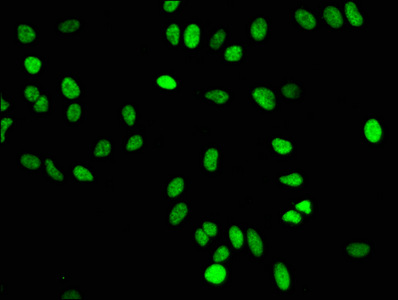
Immunofluorescence staining of Hela cells with CSB-RA010429A16me1HU at 1:50,counter-stained with DAPI. The cells were fixed in 4% formaldehyde, permeabilized using 0.2% Triton X-100 and blocked in 10% normal Goat Serum. The cells were then incubated with the antibody overnight at 4°C.The secondary antibody was Alexa Fluor 488-congugated AffiniPure Goat Anti-Rabbit IgG (H+L).
Mono-methyl-Histone H4 (K16) Recombinant Monoclonal Antibody
CSB-RA010429A16ME1HU
ApplicationsImmunoFluorescence, ELISA
Product group Antibodies
ReactivityHuman, Rat
TargetH4C9
Overview
- SupplierCusabio
- Product NameMono-methyl-Histone H4 (K16) Recombinant Monoclonal Antibody
- Delivery Days Customer20
- ApplicationsImmunoFluorescence, ELISA
- CertificationResearch Use Only
- ClonalityMonoclonal
- Clone ID3E11
- ConjugateUnconjugated
- Gene ID8294
- Target nameH4C9
- Target descriptionH4 clustered histone 9
- Target synonymsH4 histone family, member M; H4/m; H4-16; H4C1; H4C11; H4C12; H4C13; H4C14; H4C15; H4C2; H4C3; H4C4; H4C5; H4C6; H4C8; H4FM; H4M; HIST1H4I; histone 1, H4i; Histone 4 family, member M; histone cluster 1 H4 family member i; histone cluster 1, H4i; histone family member; histone H4
- IsotypeIgG
- Protein IDP62805
- Protein NameHistone H4
- Scientific DescriptionCore component of nucleosome. Nucleosomes wrap and compact DNA into chromatin, limiting DNA accessibility to the cellular machineries which require DNA as a template. Histones thereby play a central role in transcription regulation, DNA repair, DNA replication and chromosomal stability. DNA accessibility is regulated via a complex set of post-translational modifications of histones, also called histone code, and nucleosome remodeling.
- ReactivityHuman, Rat
- Storage Instruction-20°C or -80°C
- UNSPSC12352203
